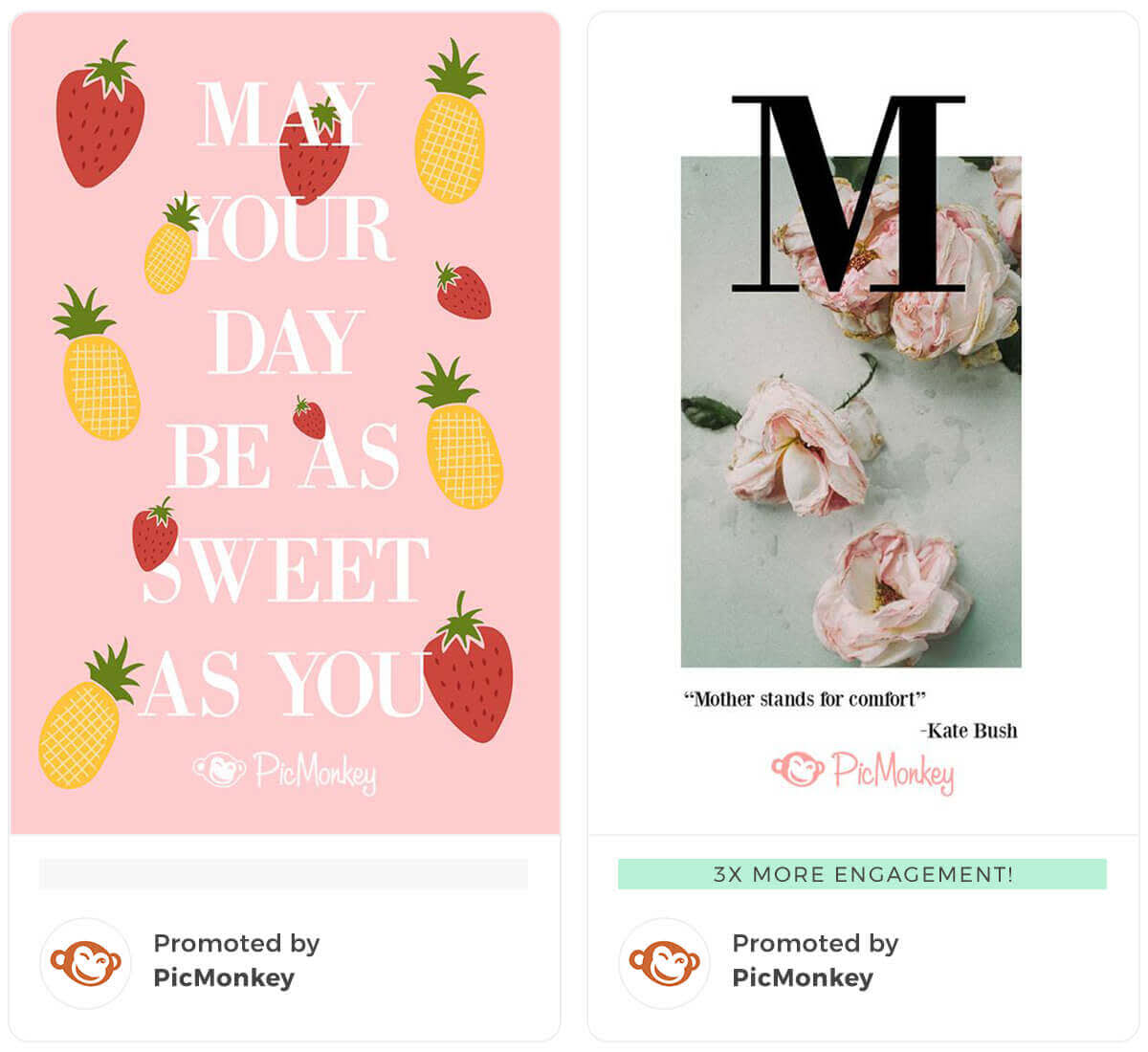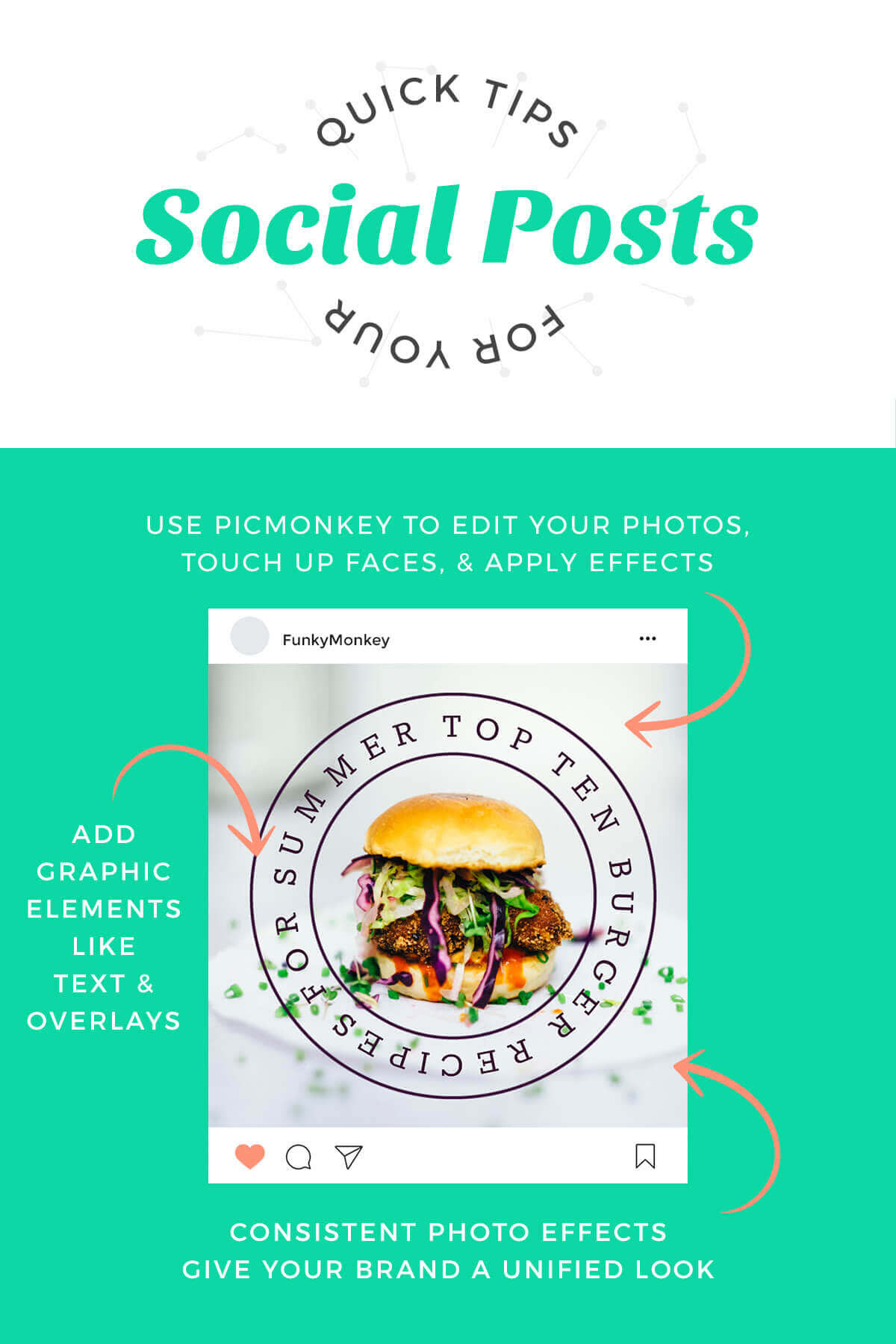In our fast-scrolling world, only the most visually arresting posts succeed. It takes 2-3 seconds to form an impression online and 94% of impressions are based upon visual stimuli. You might have spent hours creating a relevant, high quality blog post, but that may as well have been time wasted if no one notices it.

Our two Mother’s Day pins both linked to the same article, but the one on the right got 3x more engagement.
For example, earlier this year we posted two pins that linked back to the same article—the only difference between them was the image we used. Both posts had around the same number of impressions, but one of them received three times as much engagement. Images matter on social media.
Despite Twitter’s origin as a words-only platform, the company has started encouraging businesses to post tweets with images. In their own words: “[P]eople are three times more likely to engage with Tweets that contain videos and photos.” According to Buffer, tweets with images received 89% more favorites and 150% more retweets.

It makes sense; people are busy and they want their information fast. Good social media images are “snackable,” meaning they deliver information quickly so people can absorb it and move on. Or, like the Pinterest example above, social images can help people quickly decide whether they’re interested in learning more about the content you’re linking to. And with more and more people consuming content on their phones, large, arresting images are more effective (think colored Facebook posts) at getting people’s attention than blocks of text.
In this installment of The Complete Guide to Social Media Marketing we’ll show you how to create and curate engaging photos, graphics, GIFs, and videos so that you can stop scrollers in their tracks and earn more traffic and engagement.
Shoot your own pictures or source stock photos?

Now that you understand how important images are to your social media efforts, let’s compare the two main ways you can get your hands on some photos—taking your own and using stock photographs.
The pros of taking your own pics
Taking your own photos is a great way to give your brand an authentic look and feel. Photographing your employees at work and play will establish your company branding and show off your work culture. For example, when we launched our mobile touch up feature, we took photos of some of our employees and made videos for Instagram that teased the feature.
You gain complete creative control over what goes into your images, from the way people are interacting with your brand, down to the lighting and composition. This is really helpful if you’re trying to adhere to a certain brand aesthetic.
It’s possible to achieve a high quality look and feel without shelling out big bucks for a professional photographer or fancy camera. The cameras on most of today’s smartphones are powerful enough to take a good picture for social media. Again, when you’re taking the photo pay attention to the lighting and composition.
Whether your photo comes out amazingly or it’s just okay, as a final step you’ll want to apply some edits.
The cons of taking your own pics
Taking your own photos can often be time consuming—even though it seems like a “free” option, sometimes using stock photos can be a lot more cost effective. Also, your images become limited by the location that you’re in and what’s immediately around you.
The pros of using stock photos
If the first thing that comes to mind when you think of stock photos is weird, cheesy images, we have some exciting new for you. These days there are tons of options for finding beautiful, non-awkwardly posed images.
There are many sites that host free stock images, but if you’re looking for some with a slightly wider selection/better image quality, we’d suggest the following paid options:
iStock by Getty images. This site has a super extensive library so you might need to dig a little bit, but you can find some great photos here.
Stocksy. These pictures are high quality and have a little bit of a funky flare. This is a good place to look for Insta-ready pics.
500px. Most of the photos from this site have never been used in commercial campaigns before, so this is a good place to look for unique photos. Curated galleries make it easy to find what you’re looking for.
Haute Chocolate. Geared towards female entrepreneurs, this site is awash with flat lays and crisp white backgrounds. Folders make it easy to find the aesthetic you’re looking for.
Social Squares by The SC Stockshop. These stock photos are made especially for social media and are already cropped for Instagram.

Stock photos can be easily edited to fit your brand. Look for photos that haven’t been heavily edited and add your own filters so they fit better with your brand feel. Also, maybe stock photos come with blank screens where you can superimpose your own website and/or app.
The cons of using stock photos
Stock photos might require more fancy photo editing to get your product/logo/branding to fit in seamlessly and unless you buy the rights to a specific photo, other companies will still be able to use it so it won’t be unique to you. Also, if you have a specific image in mind, it might be hard to find a picture that exactly matches what you’re thinking.
The bottom line is, regardless of which photo-obtaining method you prefer, a healthy social media strategy will mostly likely include a balance of sourcing stock photos and taking your own pictures. At PicMonkey, we like to use stock images for blog covers, and as filler images in our Instagram account, however we do take most of our Instagram photos. Figure out a balance that works for you and run with it.
Create engaging graphics
Photos are great, but they’re not the only way to share a striking visual. Adding graphic elements like text or graphics to a photo is an easy way to create a branded post that says something to your followers. (Inspirational quotes, anyone?)

Graphic designs can be as involved as a full-blown illustration, or as simple as a circle over a colored background with some text. In PicMonkey, it’s easy to create your own graphic designs, whether you want to start with a blank canvas or use a design template.
We would be remiss at this point if we didn’t mention that there’s one type of graphic you can post that’s almost guaranteed to drive engagement. Infographics are amazing pieces of miracle content that you should definitely be utilizing:
Infographics are memorable. People remember 6.5x more information when it’s paired with a image than when they just hear it.
Infographics are eye-catching. According to an eye-tracking study, people more likely to pay attention to images with information on them than plain text or even decorative images.
Infographics are informative. One study showed that people who followed directions with text and illustrations did 323% better than those who just had text.
Infographics are engaging. PicMonkey’s color theory infographic pin got double the amount of engagement as our non-infographic color theory pin.
Delight your followers with GIFs
If a picture’s worth a thousand words, a GIF is probably worth like, 3,000. These eye-catching file types are midway between an image and a full-on video. Since they’re short and repeating, they’re a great way to liven up an email, make an announcement, and have some fun with your followers. GIFs can be a (lot) less formal than many other media types, so if you decide to use them, it might help to come up with some general guidelines to make sure that they’re in keeping with the rest of your brand.
Posting a GIF on one of your social channels can help you:
Show a process. GIFs can be both mesmerizing and instructional.
Grab attention. GIFs can also subtly animate an otherwise still image.
Highlight a product. Show off a neat product feature.
Crack a joke. Appeal to the meme-ish nature of GIFs.
Get a little weird. Try using the element of surprise as a way to drive engagement.
There are two types of GIFs, still frame and video. A still frame GIF uses a folder of still frames to create a short, moving picture—kind of like a flip book or an animation. Video GIFs take recorded video and compress them so that they include less frames than they usually would. The quality is lower than a video and they don’t include sound, but they can be more manageable to upload and share.
GIFs can be a (lot) less formal than many other media types. Be sure to note context for the GIF you’re picking. If it’s a meme or a pop culture reference, it could have more connotations that you might intend, so just be aware of that if you’re posting on behalf of your brand. If you decide to use them, it might help to come up with some general guidelines to make sure that they are in keeping with the rest of your brand.
It’s easy to curate GIFs using sites like Giphy and Gifbin. Be sure to note the context around the GIF you’re picking. If it’s a meme or a pop culture reference, it could have more connotations that you might intend, so just be aware of that if you’re posting it as your brand.
It’s also pretty simple to make your own GIFs. You can make a video GIF on Giphy or make Instagram-specific GIFs that play forwards and backwards using the Boomerang app. To make a still frame GIF using PicMonkey, be sure that the frames you’re making are the same size and if you’re using text, that it’s placed in more or less the same area of the frame—otherwise it will look a bit jerky. You can pop your screenshots into PicMonkey to add text and graphics and use Hub to build and use templates. Then just add the image files to a GIF converter and download the file.
Use video to drive engagement

Video is the most effective media for driving engagement—and its importance is only growing. According to a Cisco Visual Networking Index report, video is poised to account for 82% of all consumer internet traffic by 2021—and according to a recent survey, four times as many consumers say they would prefer to watch a video about a product than read about it. “After speaking to someone face to face, it’s the most powerful way to reach people,” says Fabiola Landa, social media manager at PicMonkey.
Nearly every social networking app supports video content (we’re looking at you, Instagram Stories!), but the most popular platforms for video are Facebook and YouTube. Let’s take a look at both platforms.
Facebook video tips:
Videos uploaded directly to Facebook will automatically play in people’s feeds.
85% of people watch Facebook videos without the sound on, so subtitles or inserts are a must.
According to a Buffer test, square videos are more optimal for Facebook videos, since they take up 78% more real estate on a person’s mobile screen.
The best content for Facebook is inspirational, educational, and quick. (At PicMonkey, we use our 30-second-or-less “Didja Know” series to give feature tips and tease longer videos.)
Grab your audience’s attention in the first 5 seconds. Says Landa, “You’re fighting against the feed.”
YouTube video tips:
YouTube videos can be a bit longer and are usually played with sound.
Posting videos to YouTube (especially with a transcript in the description) is a great way to increase your overall SEO.
Some of the most popular types of videos on YouTube are how-to’s, vlogs, educational videos, and Q&A videos.
The optimal size for YouTube videos is 1280 x 720 pixels.
Invest in high quality thumbnails and detailed descriptions. Because YouTube videos don’t auto-play, these are the details that help grab people’s attention.
Regardless of where you post your videos, it’s important to create a consistent look and feel. Cultivate a unique voice and use branded title and end screens and graphics. Using uniform graphics and a watermark will add to your production values and make your videos seem more professional. Check out this video to see how PicMonkey uses graphics, fonts, and slides to keep our branding consistent. (Plus, it’ll teach you how to make a YouTube thumbnail. Yay multitasking!)
Wanna make your impressions really go through the roof? Live videos can get up to 10x the reach as a pre-recorded video. Facebook and Instagram algorithms heavily favor live videos since it’s a feature they’re trying to promote. They send notifications to your followers that you’re going live and audiences enjoy the authentic, behind the scenes nature of live video. According to Landa, a recent Facebook Live video we made got over eight times our normal reach and over seven times the views.
Not sure if video is right fit for your type of business? There are many different types of videos that could work for you including:
Testimonials
Question and answer sessions
Tutorials
Vlogs
Behind the scenes looks at your business
Product demos (this is especially good for a live video!)
No matter what types of videos you make, remember “When you’re a brand, every video is a sales video,” says Landa. But that doesn’t mean you should be sales-y. “Be authentic. These days viewers shouldn’t say, ‘Oh, that’s an ad. They’re trying to sell me something.’ Be entertaining and every video you make should show them how you’re solving their problems.”
Stay tuned to the next installment to learn more about how to connect your content with holidays and trends.
